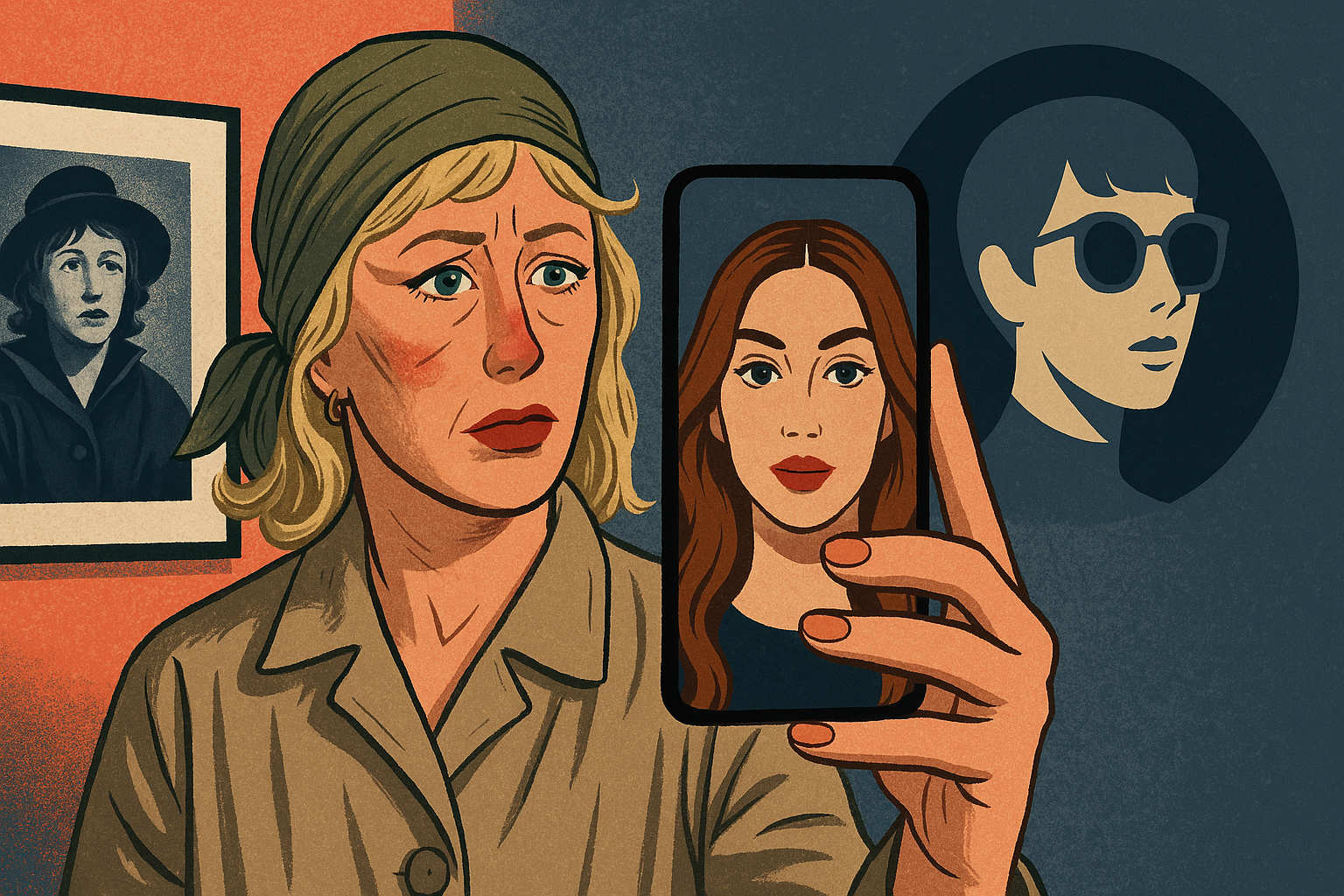Cindy Sherman and the Simulacrum of Identity: Performance, Hyperreality, and the Digital Mask


In an age where the self is endlessly curated, filtered, and commodified, Cindy Sherman’s photographs feel less like art historical artifacts and more like prophetic visions.
Since the late 1970s, Sherman has used her own body as a medium to dismantle the myth of fixed identity, exposing it instead as a performance—a series of borrowed gestures, costumes, and cultural scripts.
Her work doesn’t just depict characters; it reveals identity itself as a hall of mirrors, where every reflection refers only to another reflection, never to an original.
This concept—that identity is a simulacrum, a copy without a true referent—was central to philosopher Jean Baudrillard’s critique of postmodern culture. In Sherman’s photographs, we see this theory made visceral.
There is no “real” Cindy Sherman in her Untitled Film Stills (2003), only a chain of cinematic tropes, each one pointing to another mediated image.
Today, as we navigate the algorithmic personas of Instagram and TikTok, her work feels unnervingly contemporary. Are we, too, just performing versions of ourselves that were never really ours to begin with?
I. The Vanishing Self: Sherman as Medium, Not Subject
Sherman’s early Untitled Film Stills are often mistaken for documentary stills from forgotten movies. They are not. They are meticulously staged fictions, with Sherman herself slipping into the roles of various female archetypes—the vulnerable starlet, the Hitchcockian blonde, the suburban housewife. Yet these are not portraits in any traditional sense. Sherman does not “express herself” in these images; she disappears into them.
This act of self-erasure is radical. Traditional portraiture, even in its most stylized forms, has long been tied to the myth of the authentic self—the idea that a photograph can capture some essential truth of the sitter. Sherman’s work rejects this entirely. There is no essential self to capture, only roles to be tried on and discarded.
In later series, like Centerfolds (from 1981) and History Portraits (1988-1990), Sherman pushes further into artifice. She distorts her body with prosthetics, layers on exaggerated makeup, and mimics the visual language of fashion spreads and Old Master paintings. The more “realistic” the image appears, the more it underscores its own falseness. This is hyperreality: a copy so convincing that it replaces the very idea of an original.
II. The Feedback Loop: From Cinema to Social Media
Sherman’s work was initially a critique of mass media—the way Hollywood, advertising, and glossy magazines construct narrow, repetitive versions of femininity. But today, the feedback loop between image and identity has accelerated exponentially. Where Sherman once posed as fictional characters, we now do the same daily on TikTok and Instagram.
Consider the rise of “aesthetic” personas online: the clean girl, the dark academic, the coquette. These are not organic identities but highly stylized performances, assembled from cinematic references, influencer trends, and algorithmic pressures.
A TikToker performing “90s sitcom mom” or “indie film protagonist” is engaging in the same act of cultural mimicry as Sherman—except, in many cases, without her critical distance.
@_cassij_ #eggparents #highschoolprojects #90s #90sthrowback #90ssitcomsbelike #fyp #90ssitcoms #ilovethe90s #foryoupage #lol #sitcoms #actress ♬ original sound – Cassi J
Filters deepen this illusion. Face-altering apps don’t just “enhance” our appearance; they rewrite it entirely, generating a version of the self that never existed outside the screen. Baudrillard might argue that these digital avatars are the purest form of the simulacrum: identities that refer only to other digital identities, in an endless recursion.
III. The Paradox of Authenticity
Sherman’s work forces us to confront an uncomfortable question: If identity is performance, can “authenticity” even exist?
Social media often claims to value “realness,” but what does that mean when every “candid” moment is staged, every “spontaneous” post strategically timed? Even the backlash against performativity—the rise of “no-makeup” selfies, “relatable” content—becomes its own aesthetic. The unpolished, the raw, the “imperfect” are just another costume.
For photographers, this raises a dilemma: If all portraits are constructions, how do we approach representation ethically? Sherman’s answer seems to be to lean into the artifice, to make the construction visible. But in an era where AI-generated faces and deepfakes further blur the line between real and fabricated, her work takes on new urgency.
IV. Sherman’s Legacy: A Challenge for Digital Selfhood
Sherman’s photographs do not offer solutions. Instead, they act as a mirror (or, more accurately, a hall of mirrors) for our own mediated existences. Her work suggests that identity was always fluid, always borrowed—but now, the stakes are higher. When our digital selves are quantified, monetized, and endlessly replicated, what happens to the idea of a “true” self?
Perhaps the only way forward is to adopt Sherman’s self-awareness—to recognize that we are performing, even (especially) when we claim we’re not. The challenge for contemporary image-makers is not to escape performance but to interrogate it: to ask who constructs these roles, who benefits from them, and what happens when we step outside the frame.
Further Reflection
Do you think social media allows for genuine self-exploration, or is it inherently a theater of borrowed identities? Can a photograph ever capture something “real,” or is all portraiture, by nature, a kind of fiction?



